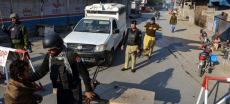[vc_row][vc_column][vc_column_text dp_text_size=”size-4″]This situation can only be managed through unconventional measures, which a political government may adoptLAHORE: Pakistan’s economy has been facing structural inflation where the average Consumer Price Index (CPI) is currently hovering around 25%. In the first five months of FY 2023, the average Sensitive Price Index (SPI) is around 28%. The worrisome aspect is that the SPI has been in double digits since July 2018. This implies that the price of essential commodities has almost doubled in the last four years.
Devaluation of the rupee has also played a pivotal role in the acceleration of prices in Pakistan. The dollar-rupee parity, kept around Rs105/$ from 2013 to 2017, and the acceleration in prices was slow. Macroeconomists, journalists and analysts heavily criticised that policy by invoking the price mechanism. They argued that the rupee was artificially pegged to the dollar. In simple words, it was not allowed to float freely, which made exports expensive and imports cheaper, worsening the trade deficit.
The rupee-dollar parity was around Rs125/$ in 2018 and the rupee touched the Rs180/$ mark in April 2022, which turned out to be unprecedented in Pakistan. Despite this adjustment in price, imports outpaced exports by a large margin and trade deficit ballooned.
Though the dollar-rupee parity is at around Rs230/$ mark, macroeconomists still argue in favour of devaluation as they believe that the price mechanism will work. It is usually conceived that the price mechanism takes time to show its results and the key to make it happen is to reform the system to bring in more flexibility.
However, in Pakistan’s case, that did not happen and the price mechanism has not been able to show results despite unprecedented devaluation. The strength of the dollar doubled in a short span of five years, showing an annual growth of around 15 %. The devaluation also accelerated producer and consumer prices, which have become a major challenge for the political government.
On the political front, the situation has been volatile since October 2021. The political temperature went up suddenly and the outgoing government was too distracted to pay attention to the economy. The political batten was handed over to the coalition government in April 2022, but the political mercury kept rising. If the government is continuously bogged down by the political situation, and is forced to remain in firefighting mode, then many much-needed reforms and issues will stay remain on the backburner – including structural reforms. Structural inflation and devaluation pose their own set of challenges for the government. A high policy rate international environment is also aggravating the situation. Most of the international central banks are raising their key policy rates, with dollars flowing back to the host countries to avail the benefits of a rise in interest rates.
Though Pakistan is under the Extended Fund Facility (EFF) of the International Monetary Fund (IMF), the country is still experiencing a scarcity of dollars. The pent-up demand for dollars, in the presence of inadequate supply and rationing measures introduced by the government, has created a black market. In that dark channel, people pay a premium price, while the profiteers squeeze the maximum benefit out of the situation.
In a nutshell, the economy is experiencing a host of domestic and international political economy challenges. The heightened political and economic uncertainties have provided lots of opportunities to speculators and profiteers to rule the roast. This situation can only be managed through unconventional measures, which a political government may adopt. Here the will of the political government is the key. The political mercury is slowly coming down. We may expect a slight improvement in economic situation in the coming months[/vc_column_text][/vc_column][/vc_row]











